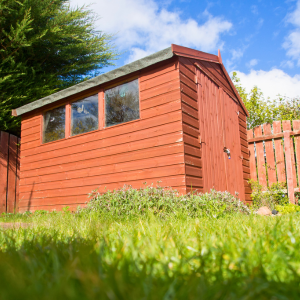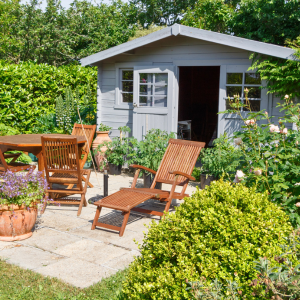This handy guide will help you to establish whether you need planning permission for a shed, outbuilding or other garden structure.Our specialist property solicitors are available on 01225 462871. Alternatively, submit the Contact Form below. |
Do I need planning permission for a shed?
 “Do I need planning permission for a shed in my garden?” It’s a surprisingly common question we encounter. And it’s reassuring that most people are alert to the need to check where they stand before erecting any form of garden structure.
“Do I need planning permission for a shed in my garden?” It’s a surprisingly common question we encounter. And it’s reassuring that most people are alert to the need to check where they stand before erecting any form of garden structure.
As a property owner, it’s your responsibility to ensure that any structure erected satisfies all relevant planning rules and building regulations. If you don’t, you can find yourself forced to remove it. So, should you have any doubt at all as to what, if any, permissions you will need, always discuss your plans with your local planning department. Use this helpful link to find their contact details.
Shed planning permission
 A change in the law in 2008 means outbuildings benefit from “permitted development rights”. This means that as long as you satisfy specific criteria, outbuilding planning permission is automatically granted. In other words, there’s no need for an application.
A change in the law in 2008 means outbuildings benefit from “permitted development rights”. This means that as long as you satisfy specific criteria, outbuilding planning permission is automatically granted. In other words, there’s no need for an application.
The rule applies to various structures, including – but certainly not limited to – sheds, garages and greenhouses. But the crucial thing is that the erection of the outbuilding must be for a “purpose incidental to the enjoyment of the dwelling house”. So, it will also cover structures as diverse as beehives, domestic heating oil tanks, dog kennels and sauna cabins.
On the other hand, if the structure is intrinsic to the functioning of your house, then it’s likely you will need planning permission. So, for example, it will not cover self-contained accommodation or even just a bedroom.
Permitted development outbuildings
Your proposed structure has permitted development rights if it meets the following criteria (note – all measurements are external):
- It is for domestic use only by the house’s occupants and contains no sleeping accommodation.
- Excluding the area occupied by the house, the structure does not cover more than fifty per cent of the garden.
- The structure is not located on land forward of a wall forming the principal elevation – i.e. not in front of your house.
- The structure is single-storey with an eaves height not exceeding 2.5 metres, with a maximum overall height of 4 metres if the roof is dual-pitched, or 3 metres in any other case.
- If the structure is within 2 metres of the property’s boundary, the entire building must not exceed 2.5 metres high.
- The structure has no veranda or balcony.
- Raised platforms associated with the structure, such as decking, should be no higher than 30 centimetres from ground level.
- The floor area of the structure does not exceed 15 square metres. (Note that up to 30 square metres may fall under permitted development, providing other conditions are also met).
The government has produced a technical guide to permitted development rights, available online.
Exceptions
Of course, there are always exceptions to the rule! Here are a few examples:
- Bedrooms and bathrooms: if you intend to install either in your shed or outbuilding, always check permissibility. Self-contained accommodation requires both planning permission and building regulation approval.
- Home office: if you plan to run a business from a garden office, you will generally need planning consent. However, this is usually very straightforward unless it will attract significant visitor numbers.
- Animals: as long as it’s for the domestic needs or personal enjoyment of the house’s occupants, pets, poultry, other birds, or even livestock are usually permitted in an outbuilding.
- Designated land: includes land in conservation areas, World Heritage Sites, areas of outstanding natural beauty, and national parks. So, if your land falls within such a protected area, permitted development rights apply only in certain cases. To qualify, the maximum total area covered by any outbuildings situated more than 20 metres from any house wall must not exceed 10 square metres. There are also other restrictions, and again, you should always check with your local planning authority.
- Listed buildings: if your house is listed, you will probably need Listed Building Consent for any building operations. And if the proposed structure is on land immediately surrounding a listed building, you will likely need to submit a planning application. That is unless the local authority has already granted listed building consent.
Find out here whether building regulation approval is required for your garden structure. Most do not, but it’s always advisable to check.
You can use the government’s Planning Portal if you require planning permission.
Do you need planning permission for a brick shed?
The same rules apply irrespective of the material used for construction.
What is the maximum size shed without planning permission?
In most cases, you will not need planning permission if your shed is:
- under 2.5 metres tall at the eaves;
- intended for a use that’s incidental to the enjoyment of your house;
- situated in your back garden;
- away from property boundaries.
If you create a bedroom, install a toilet, or plan to run a business from the building, in all likelihood, you will need planning permission.
But it’s always worth calling your local planning authority to check.
Shed within 1 metre of boundary
Before carrying out any work close to a party wall, always check whether the provisions of the Party Wall Act 1996 apply. For more details of the rules, see our main Party Walls page.
